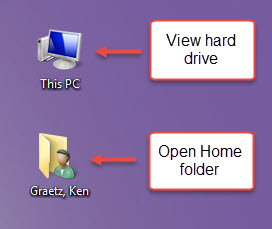Difference between revisions of "Draft:Backing up files on your PC"
| Line 26: | Line 26: | ||
Writable DVDs, SD cards, and external hard drives are not recommended for important, school-related file storage and cannot be used to store private university data. You use them at your own risk. | Writable DVDs, SD cards, and external hard drives are not recommended for important, school-related file storage and cannot be used to store private university data. You use them at your own risk. | ||
*[[Saving files to external storage media from a PC |Saving files to external storage media]] | *[[Saving files to external storage media from a PC |Saving files to external storage media]] | ||
| − | *Learn more about external storage media | + | *[[External storage|Learn more about external storage media]] |
[[File:Pc 840 desktop.jpg|right|frame|Fig 1. Hard drive and home folder icons for HP 840]] | [[File:Pc 840 desktop.jpg|right|frame|Fig 1. Hard drive and home folder icons for HP 840]] | ||
Revision as of 13:56, 23 May 2015
About this article
This article includes instructions and suggestions for backing up your school-related and personal files on your WSU Windows-based PC. It is intended for any student or employee.
Before you begin
Before you start copying and pasting files, please consult the following articles as needed:
- How much data do you have to back up? You can check how much space you are using on your current laptop's hard drive to estimate how much room you will need for your backup files.
- Where are your files? Do you know where all your files are located? Make sure to check the most common storage locations.
- Do you have family photos, home movies, and other personal files stored on your laptop? Consult our policies and guidelines regarding the appropriate, personal use of WSU computing resources.
- Are you backing up private university data? Learn more about where such data can and can't be stored.
When it comes to storing school-related and personal files, you have several choices:
Microsoft OneDrive for Business
This is our "cloud storage" solution, a fancy way of saying that your data is stored on off-campus servers owned by Microsoft. Once you have stored your files in your OneDrive for Business, you can access them from any computer with an Internet connection, anywhere in the world. You can also access your OneDrive for Business using a tablet or smartphone. This is the only cloud storage option supported by WSU.
WSU local network storage (employees only)
Sometimes referred to as your "R Drive," this campus storage space can be accessed from your laptop while on campus and from off campus using VPN.
- Saving files to your personal network storage
- Learn more about your personal network storage
External storage media
Writable DVDs, SD cards, and external hard drives are not recommended for important, school-related file storage and cannot be used to store private university data. You use them at your own risk.
Copying your Home folder
A quick way to backup most of the files you have stored on your hard drive is to make a copy of your Home folder. This is the folder on your desktop labeled with your name (Figure 1). Your Home folder contains all of the default folders created for you when you received your computer, including your Documents, Music, and Pictures folders. It also includes your Desktop folder. For more information on the Home folder, consult: Where on your laptop are your files.
Steps
- From your Desktop, right-click on the Home folder icon (the one with your name on it, not This PC) and choose Copy
- Open up your personal network drive or external hard drive, right-click somewhere in the window, and select Paste
- You may need to select Yes if asked to provide Administrator access
Important information
- You cannot paste your Home folder, or any folder, into your OneDrive for Business.
- Don't just copy your Home folder blindly. Make sure you understand what is contained within it. Check the size of your Home folder before you copy it
- Your Home folder contains a large, hidden subfolder used by Windows called AppData. You do not need to copy this subfolder. Before you copy your Home folder, make sure View Hidden Files is unchecked and the copy process will bypass it.
- The copy process may take some time if you have a lot of files in your Home folder and you are copying it to an external disk.
- Restoring files from your Home folder may not always be as simple as overwriting your new computer's Home folder. There is no guarantee that your Home folder on your new computer will be structured exactly the same way as the Home folder on your old computer. In some cases, you may need to restore your files from your backup Home folder a subfolder at a time.

